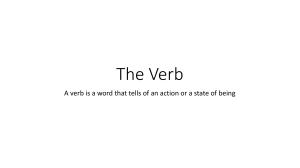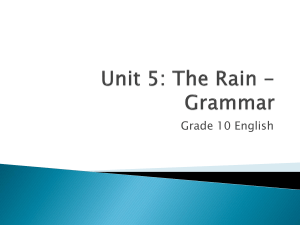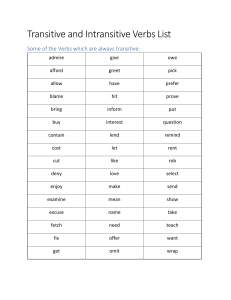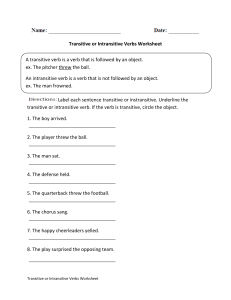Uploaded by
mariabelenfernandez601
Transitive & Intransitive Verbs: English Grammar Lesson
advertisement
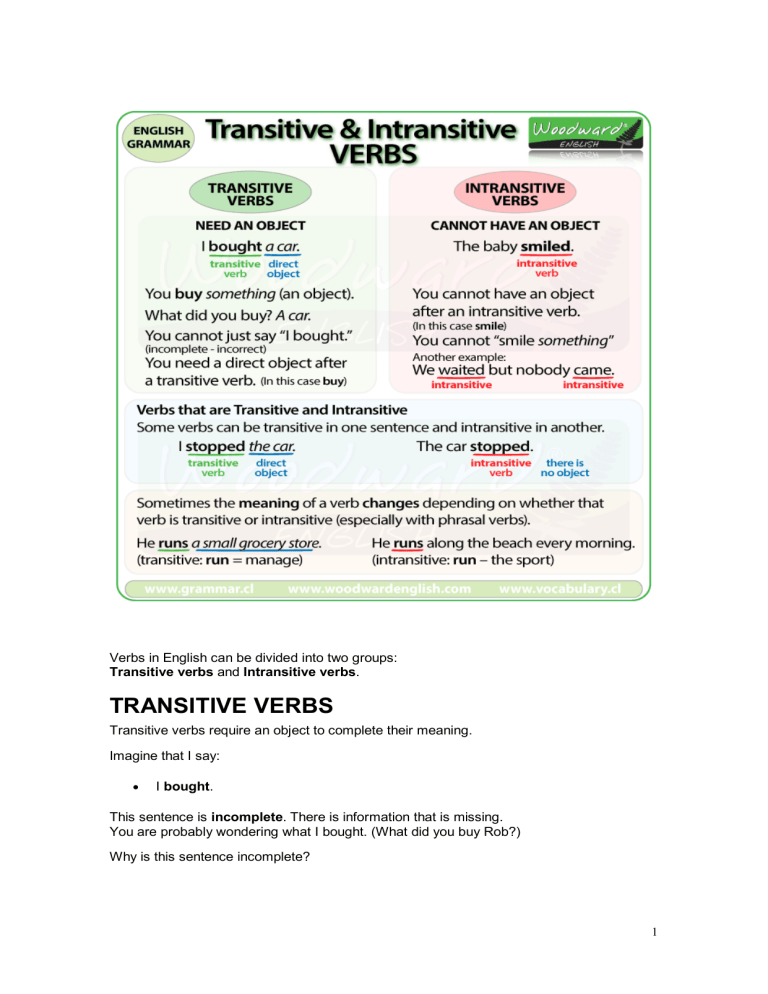
Verbs in English can be divided into two groups: Transitive verbs and Intransitive verbs. TRANSITIVE VERBS Transitive verbs require an object to complete their meaning. Imagine that I say: I bought. This sentence is incomplete. There is information that is missing. You are probably wondering what I bought. (What did you buy Rob?) Why is this sentence incomplete? 1 Because BOUGHT (the past of buy) is a transitive verb and a transitive verb needs an object after it to complete the sentence. The object after a transitive verb can be a noun or a pronoun. I bought a car. Now the sentence is complete and we can understand it. We added the object “a car” after the verb. Let’s look at some other examples. If someone says: She likes. (incomplete - incorrect) You probably think … She likes WHAT? (What does she like?) Like is a transitive verb so we need an object after the verb. She likes chocolate. Now we know what she likes so this sentence is complete and correct. I invited Angelica. You cannot just say I invited because the sentence is incomplete. The person who is listening would probably ask “Whom did you invite?” So we need an object (in this case a person) after the transitive verb invite. I cut my finger. You cannot just say I cut because the sentence is incomplete. The person who is listening would probably ask “Cut what?” Cut is a transitive verb because you need to cut something (an object, a thing). The man stole a bike. We need to say WHAT the man stole in order to understand the sentence/situation. Steal (stole is the past tense of steal) is a transitive verb. The object in this sentence is the bike. So we have seen that transitive verbs need an object after them. This object receives the action of the verb. Transitive verbs always ask “what?” or “whom?” What did you buy? – I bought a car. What did you cut? – I cut my finger. Whom did she invite? – I invited Angelica. Subject + transitive verb + object The same rules apply to phrasal verbs. If someone says: “I’m looking for” You would automatically think “Looking for what? Looking for whom?” 2 We need to add an object to make the sentence complete. I am looking for my passport. My passport is the object (that you are looking for) More about transitive phrasal verbs here: Transitive and Intransitive Phrasal Verbs Transitive Verbs – Passive Form Transitive verbs can have a passive form. Active: Subject + transitive verb + object Passive: Object + was/were + transitive verb (+ by subject) Thieves stole his car. (active) His car was stolen. (passive) Thomas Edison invented the light bulb. (active) The light bulb was invented by Thomas Edison. (passive) They sold some books. (active) Some books were sold. (passive) INTRANSITIVE VERBS Intransitive verbs cannot have a direct object after them. The subject is doing the action of the verb and nothing receives the action. An intransitive verb does not pass the action to an object. He arrived. Here we cannot have an object after the intransitive verb arrive. You cannot “arrive something” (incorrect). An intransitive verb expresses an action that is complete in itself and it doesn’t need an object to receive the action. The baby smiled. Here we cannot have an object after the intransitive verb smiled. You cannot “smile something” (incorrect). The apple fell from the tree. You cannot “fall something” so the verb is intransitive. “From the tree” is not an object, it is an adverbial phrase ( = it acts like an adverb and tells us where it happened). The same rules apply to intransitive phrasal verbs. You cannot have an object after an intransitive phrasal verb. I get up at 6 every morning. Example sentences using INTRANSITIVE verbs 3 We arrived around midday. She sneezed loudly. Your baby cries a lot. His grandfather died last year. The rain fell heavily. I was waiting but nothing happened. The jokes were not funny and nobody laughed. I walk to work every day. We sat on the bench. He stood in the corner. We waited but nobody came. Verbs that are Transitive and Intransitive Many verbs can be both transitive and intransitive. They can be transitive in one sentence and intransitive in another sentence. (These are called ambitransitive verbs) You have grown since I last saw you. (intransitive) You have grown a beard since I last saw you. (transitive) Sometimes the meaning changes depending on whether the verb is transitive or intransitive He runs along the beach every morning (intransitive: run – the action/sport) He runs a small grocery store (transitive: run = manage) The plane will take off in five minutes. (intransitive: take off = to leave the ground and begin to fly) Please take off your shoes before entering the house. (transitive: take off = to remove something) Example sentences of verbs that are both transitive and intransitive (transitive) - (intransitive) I stopped the car. – The car stopped. I broke my coffee mug. – My coffee mug broke. The summer heat melted my ice cream. – My ice cream melted. She speaks Arabic. – She speaks very quickly. Mike is reading a book. – Mike is reading. New Zealand won the match. – New Zealand won. Exercise Transitive and Intransitive Verbs Directions: Underline the verb once and write VI if it is an intransitive verb and VT if it is a transitive verb. If there is a direct object, underline it twice and write DO. Example 1: Janie kicked the ball in the goal. VT 4 - Janie kicked what? The ball Example 2: Shirley sneezed in the garden. VI - Shirley sneezed what? - There is no answer to this question; therefore it is an intransitive verb. “In the garden” lets us know “where” not “what” and is therefore a prepositional phrase and not a direct object. 1. Amanda kicked Joe under the table. 2. I paid the bill last week. 3. James went to the campus café for a bowl of chicken soup. 4. We arrived at the classroom door with only two seconds to spare. 5. Susan complained bitterly. 6. Rosa always eats before going to school. 7. Scarlett wants a proposal from Rhett, the handsome but frivolous soldier. 8. Alice wrote a love poem on yellow paper. 9. During cross country practice, Damien runs over hills, through the field, across the river, and along the highway. 10. Bobby eats mashed potatoes drenched in gravy. Valency patterns The main verb in a clause determines the other elements that are required in that clause. The pattern of the clause elements is called the valency pattern for the verb. The patterns are differentiated by the required clause elements that follow the verb within the clause (e.g. direct object, indirect object, subject predicative). All valency patterns include a subject, and optional adverbials can always be added. There are five major valency patterns: 1. Intransitive Pattern: subject + verb (S + V) Intransitive verbs occur with no obligatory element following the verb: subject More verb people came. 2. Monotransitive Pattern: subject +verb + direct object (S + V + Od). Monotransitive verbs occur with a single direct object: subject She verb direct object carried a long whippy willow twig. 5 3. Ditransitive Pattern: subject + verb + indirect object + direct object (S + V + Oi + Od). Ditransitive verbs occur with two object phrases-an indirect object and a direct object: subject Fred Unsworth verb gave indirect object her direct object a huge vote of confidence. 4. Complex transitive Patterns: subject +verb + direct object + object predicative (S + V + DO + Co) or subject +verb + direct object + obligatory adverbial (S + V + DO +A). Complex transitive verbs occur with a direct object (a noun phrase) which is followed by either . (l) an object predicative (a noun phrase or adjective), or (2) an obligatory adverbial subject verb direct object complement of the object 1 people called him Johnny. subject He 2 verb put direct object his hand obligatory adverbial on the child's shoulder. 5. Copular Patterns: subject +verb + subject predicative (S + V + Cs) or subject +verb + obligatory adverbial (S + V + A). Copular verbs are followed by (1) a Complement of the subject (a noun, adjective, adverb or prepositional phrase) or (2) by an obligatory adverbial. 1 subject Carrie 2 subject I (copular) verb felt (copular) verb 'I1 keep complement of the subject a little less bold. obligatory adverbial in touch with you. EXERCISES Lexical verbs occur in clauses with one of five different valency patterns: intransitive, monotransitive, ditransitive, complex transitive, and copular. Underline all lexical verbs in the sentences below. 6 Identify the valency of each verb, and the clause elements that follow each main verb (including optional adverbials). PART A 1 I told dad stuff about Georgia. told = ditransitive; - dad=indirect object staff about Georgia: direct object Pattern: (S + V + I0 + DO). 2 We went to Disneyland. 3 He smiled into my eyes. 'I've got news for you.' 4 A: A dog found it in the street. B: Do you want that other piece? 5 Usually these dogs bark a lot- He looks really tired. 6 He called her a stupid idiot. 7 Put it on that table, where all the other folders are. 8 U.S. officials considered them a serious threat to U.S. peacekeeping troops. 9 In a study published last year Wells found that many HMO doctors prescribe minor tranquillizers. 10 Plans for the Botanical Garden started about a decade after two American botanists made an 1887 visit to England that included a stop at London's prestigious Kew Gardens. 11 This lightly effervescent Italian white wine seemed sharp at first. Identify the valency pattern of each verb: copular, monotransitive, ditransitive, complex transitive or intransitive. 7 a. b. c. d. e. f. g. h. i. He gave the student his exam. The instructor taught us how to land safely. Your brother appears ill today. He went to the fair. They are nice French students. Peter keeps his coins in the tool box. We keep the cars in the garage. John became my friend. He became angry. 8
